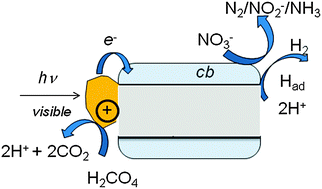Aqueous phase photocatalytic nitrate destruction using titania based materials: routes to enhanced performance and prospects for visible light activation
Abstract
Use of titania based photocatalysts for the selective reduction of nitrates to nitrogen through photocatalytic methods has attracted some interest in recent years and the need to operate this process remotely and without energy sources will ensure that a level of interest will remain in attempting to improve this process. There remain numerous avenues that have not yet been investigated in the effort to optimise a catalyst for this reaction. Work on metal containing systems offer the potential to; improve activity through offering a route to improved electron-hole separation, manipulate selectivity by controlling particle size which affects the flat band potential under Fermi equilibration conditions and for operation in the visible region by manipulating particle shape and using SPR properties. Opportunities to further manipulate all three of these situations by using bimetallic particles using core-shell, true alloy and other forms, remains open for exploration. The introduction of hetero-species into bulk titania in order to reduce the band gap and permit operation within the visible region. The key issues in the case of the reaction involved would be to retain the oxidation potential of the valance band but to sacrifice the reduction potential of the conduction band thus permitting nitrate reduction but avoiding competition for electrons by protons in solution. In a more general approach, the key challenge should be to obtain a route to uniform bulk doping without the need to use complex ion implantation routes. Composites offer the opportunity to manipulate adsorption capacity although as yet, attempts to improve nitrate adsorption with respect to other organic anions has not been attempted. They may also be used to improve electron transfer properties and to enhance charge-carrier lifetimes.


 Please wait while we load your content...
Please wait while we load your content...